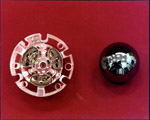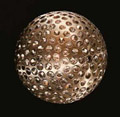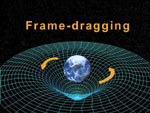WEEKLY HIGHLIGHTS FOR 22 OCTOBER 2004:
GRAVITY PROBE B MISSION UPDATE

On Day #185, GP-B continues to perform well. We have switched back to flying
the spacecraft drag-free around gyro #3, and all four gyros are digitally suspended
and generating science data. The spacecraft’s roll rate remains constant
at 0.7742 rpm (77.5 seconds per revolution), and all subsystems are continuing
to perform well. As we near two months of data collection, the flow of helium
from the Dewar through the micro thrusters remains within expected limits,
and the Dewar temperature is stable at 1.82 Kelvin. We have approximately seven
months of data collection remaining, and the quality of the data received thus
far continues to be excellent.

This past Tuesday, October 19th, gyro #1, which has been serving as the “drag-free” gyro
for the past few weeks, transitioned into analog backup suspension mode. Having
already worked through this same scenario with gyro #3 last month, we were
able to smoothly switch drag free operations back to gyro #3 and restore digital
suspension to gyro #1 within three hours of this event. Because gyro #3 has
been performing well after we increased the signal to noise ratio in its Gyro
Suspension System (GSS) position readout, we have made the same adjustment
to gyro #1. We are now monitoring the performance of both gyros #3 and #1 to
determine if the analog suspension transition will recur, or if this issue
has been resolved.
The oscillations in the drag-free control force, which we have been reporting on in previous highlights, have remained at an insignificant level over the past week. We are performing further analysis and adjustments on the drag-free suspension parameters to ensure the de-tuning of any harmonic coupling between the drag-free control system and helium sloshing in the Dewar. We are continuing to monitor the drag-free control system with regard to this issue.
We have received inquiries about a recent letter to Nature by Ignazio Ciufolini and Erricos Pavlis claiming to have verified the Lense-Thirring frame-dragging effect of general relativity through laser ranging data observations of the LAGEOS I & II spacecraft. In their measurement, the frame-dragging effect needs to be separated by an extremely elaborate modeling process from Newtonian effects more than 10,000,000 times larger than the effect to be measured. The letter does not provide enough detail of the methods of verification and validation to allow a critical evaluation. We and other members of the relativity community look forward to a more complete account. If verified, their result will be of considerable interest.
The GP-B science instrument and spacecraft were specifically designed to create
a pristine environment to perform direct measurements of both the frame-dragging
and geodetic effects of general relativity with all Newtonian disturbances
several orders of magnitude smaller than the effects to be measured. Theoretically,
only one gyroscope is needed to make GP-B's measurements, but we use four gyroscopes
to give highly accurate independent checks of the two effects. As a further
validation, throughout the whole GP-B mission we conduct a continuing series
of verification/calibration tests. In particular, during our final month-long
instrument re-calibration following data collection, we will perform a series
of tests in which certain classes of potential disturbances are deliberately
increased in order to uncover any previously unknown effects. Tests of this
kind, where possible disturbances are enhanced in order to calibrate and remove
them, are a vital part of good experimental physics practice.
Drawings & photos: The drawing of the GP-B spacecraft, locked onto the guide star, the red gyro photo, and the diagram of the frame-dragging effect are all from the GP-B Image Archives here at Stanford. The photo of the LAGEOS I satellite is from NASA. Click on the thumbnails to view these images at full size.
Please Note: We will continue updating these highlights and sending out the GP-B email update on a weekly basis—at least through the first few weeks of the Science Phase of the mission. As mission operations become more routine, we may reduce the frequency of these updates to biweekly. However, from time to time, we intend to post special reports and special updates, as warranted by mission events.
SWISS AMATEUR ASTRONOMER PHOTOGRAPHS GP-B GP-B SPACECRAFT IN ORBIT WITH GUIDE STAR IM PEGASI
To the right, is a thumbnail of a photograph of the GP-B spacecraft in orbit, along with the guide star, IM Pegasi. (Click on the thumbnail to view the photo at full size.) The photo was taken and emailed to us by Stefano Sposetti, a Swiss physics teacher and amateur astronomer. Stefano used a 40cm newtonian telescope, with a CCD camera and 20mm wide field lens attached to make this photo. He then sent us the two versions shown — the normal (black sky) version on the right, and an inverse version in which the constellation, Pegasus, the guide star IM Pegasi, and the path of the GP-B spacecraft are highlighted for easy identification on the left.

We are grateful to Stefano for sending us this wonderful photo. You can view other astronomical photos that he has taken on his Web page: http://aida.astronomie.info/sposetti. Following is Stefano's description of his photo:
In this picture one can see the quite dim GP-B satellite traveling from North (up) to South (down) direction. The bold line in the right part of the left image represents the satellite trail just before entering the earth shadow. (Every satellite becomes visible because it reflects the sunlight). The connecting lines show the constellation Pegasus. The small circle around the star is IM Pegasi, the guide star used by the spacecraft's telescope in his experiment! GP-B is a circumpolar satellite following a free fall trajectory about 640km above the earth surface. From my location the satellite passed that night at a maximum elevation of 87degrees, thus not exactly overhead. The brightness of the satellite was between 3mag and 4mag. The Moon, about in the last quarter phase, illuminated the sky and was a drawback for having a good signal/noise ratio of the satellite trace. I took this 60-seconds black and white CCD picture with a 20mm,f/2.8 lens on august 6 centered at 01:19:00 UT. North is up, East is left.
More links on recent topics
- Track the satellite in the sky
- Photo, video & and news links
- Build a paper model of the GP-B Spacecraft
- Following the mission online
- Our mailing list - receive the weekly highlights via email
- The GP-B Launch Companion in Adobe Acrobat PDF format. Please note: this file is 1.6 MB, so it may take awhile to download if you have a slow Internet connection.
Previous Highlight
Index of Highlights


